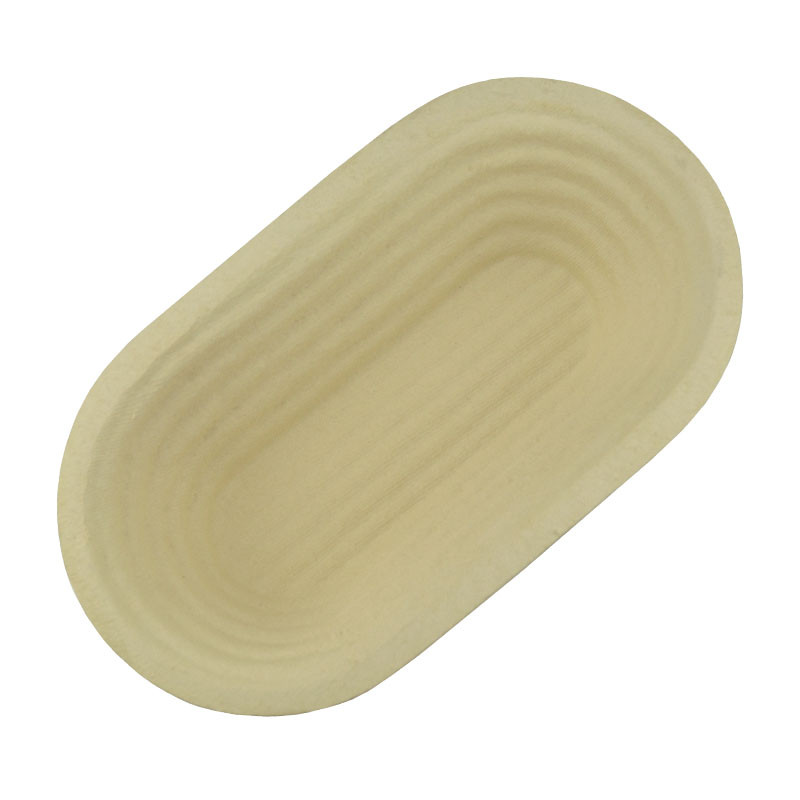



A proofing basket ensures optimal piece proofing, the wooden moulds store heat that helps the dough to rise, absorb moisture well, guarantee good dough release and are easy to clean afterwards. The baskets are made of compressed spruce wood fibers, so they are natural and ecological. This wood pulp mold is suitable for about 500 g of dough.
Data sheet
By using a proofing basket, the piece proofing of the bread becomes nice and even. In addition to the great pattern on the surface, this also results in a nicer shape and an even and finely chipped crust. Wooden moulds offer many advantages over other proofing baskets.
Instead of peddigree, which is obtained from palm trees, spruce wood from sustainable forestry is used for the production of these baskets. Stone rolling and water are used to press the wood into fibers, which are then shaped and dried with the help of a pressing tool. The cellulose fibers thus combine to form a stable fabric, natural ingredients of the wood, such as ligin, provide a slight yellowing and yellowing of the basket.
The dense cellulose fabric retains the heat of the dough better than, for example, the coiled rattan baskets. Since it is a gapless, smooth basket, the bread dough comes off better after fermentation, and even soft dough cannot stick in grooves. The basket thus gives the dough piece a great shape and an elastic dough skin during the piece proofing, but it is not suitable as a baking mold and must never be baked with.
First, of course, you need to prepare your dough. Make your favorite bread dough with yeast or sourdough and let it rise according to the recipe. Once the leavening is over, you can prepare the proofing basket.
Remove any dirt residues from the basket, this can be done with a brush, for example, otherwise you can simply turn the basket over and tap it out a little. To prevent the bread dough from sticking to the basket afterwards, sprinkle it well with flour or baker's starch. Baker's starch also has the advantage that the bread will shine nicely if you coat it with a little water before baking. Of course, you can also use a proofing basket cover.
Depending on the quantity portion your dough and then form individual dough pieces. Once you are satisfied with the consistency and shape, the bread is placed in the proofing basket. Covered with a dough plastic or proofing basket cover, let the dough stand at room temperature for as long as indicated in the recipe.
Now the bread is turned out of the proofing basket. The dough can be placed either directly on a baking paper or, if available, on a previously heated bread baking stone or in a cast iron pot that is also hot. The proofing basket should never be baked with it. Finish baking the bread according to the recipe. Once the bread is out of the oven, it can be used to dry the proofing basket. To do this, it must first cool down to a maximum of 120 °C. Then the proofing basket can be placed in the still warm oven to dry out.
Once the basket is completely dry, simply tap out any excess flour. If there are still smaller dough residues, remove them with a long bristled brush. The basket must never be cleaned in the dishwasher and running water is also not suitable for cleaning it. Depending on the frequency of use, the proofing basket should be sterilized every four to eight weeks at 100 to 120 °C for 30 to 40 minutes. Completely dry, the wood pulp molds can also be stacked without any problems and stored in a place with good ventilation.

A proofing basket ensures optimal piece proofing, the wooden moulds store heat that helps the dough to rise, absorb moisture well, guarantee good dough release and are easy to clean afterwards. The baskets are made of compressed spruce wood fibers, so they are natural and ecological. This wood pulp mold is suitable for about 500 g of dough.